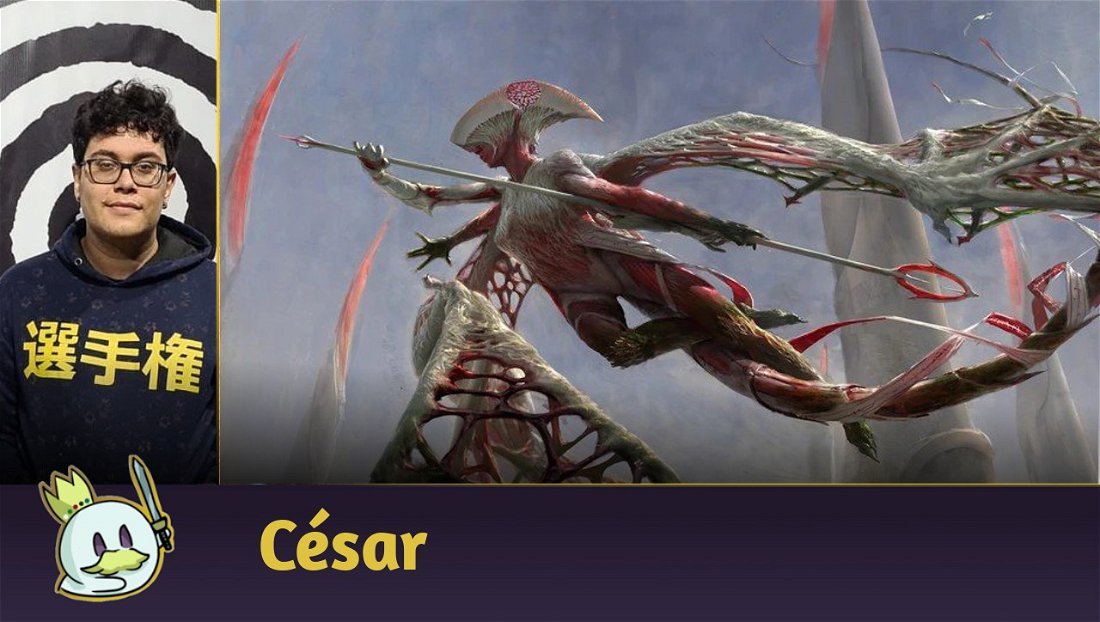The RCQ season in the Standard format is approaching! After almost four years, the format will return to the center of competitive tables in local stores to define the next qualifiers for the Pro Tour.
In today's article, we will present Gruul Stompy, a cheap, efficient strategy capable of guaranteeing quick victories - whether against players unprepared to deal with the deck, or through mastery of its threats and resources!
What is Gruul Stompy?
As its name suggests, Gruul Stompy is an aggressive deck whose strategy is as old as Magic itself: putting low-cost creatures into play and using pumps to finish off your opponent in as few turns as possible - it's a very straightforward Aggro, with little to no micro-interactions other than understanding the ideal timing for casting your spells and ensuring that no threat is played in vain.

Resource efficiency is the key word for it. The lower the cost of your spells, the more of them you can cast in a single turn, or the more explosive your plays can be without opening yourself up too much to removals and other types of interactions that can ruin your game plan.
Its weakness, however, is that the lower the mana value of your cards, the less lasting impact they have. After a few turns, your topdeck worsens substantially, and there is not much that can be done without giving up speed to improve certain matchups by favoring a more interactive game, going against the core strategy of this archetype.
The Decklist
This is the list I run in Magic Arena ranked matches.
Overall, the list and numbers fit the patterns we usually see in this archetype, with some brief changes to Sideboard choices, in addition to the use of Tyvar's Stand in the main deck instead of Mirran Banesplitter or Royal Treatment.
Maindeck

Our one-drops and main cards that enable this type in the current Standard.
Monastery Swiftspear is one of the best creatures in current Standard, and perhaps the most aggressive one-drop in the format. With so many pumps and low-cost spells, it's not difficult to make it deal between six and ten damage in a single turn.
Cacophony Scamp seems unimpressive, but alongside pumps and spells that guarantee evasion, such as Audacity and Monstrous Rage, the Phyrexian goblin can create a "combo-kill", where we can sacrifice it after combat damage to end the match. This damage can also be redirected towards a problematic threat, such as Sheoldred, the Apocalypse.

Picnic Ruiner is another creature that benefits greatly from Audacity and Monstrous Rage, which operate as a pseudo-Embercleave, granting double strike to the creature in addition to increasing its power.
Questing Druid is our only source of value and attrition, with an efficient "draw 2" and a body that becomes a threat with few spells. It gives us an extra breath when our creatures are destroyed and/or when the opponent establishes an efficient board.
Yavimaya Iconoclast is the card I dislike most on the list, but it seems like a necessary evil to keep aggression at an evasive clock. Its kicker triggers Picnic Ruineras well, and the accurate sequencing of pumps makes it an excellent surprise threat.

Our pumps.
Kumano Faces Kakkazan is closer to an extra threat than a pump, but its additional counter in the second chapter makes a difference. In total, this card guarantees three more power on the battlefield and another body to use other spells.
Audacity and Monstrous Rage are two of the best spells on the list, as they guarantee an permanent power boost in addition to trample, essential alongside our main creatures.
Ancestral Anger is another efficient resource for us to try to expand our reach or even perform a "combo-kill" while replacing itself.
The fact that this list runs Giant Growth is almost symbolic of how old this strategy is, since this was the first instant-speed pump that became popular in the game since its launch in Alpha. Here, it serves as a combat trick as well and works against damage-based removals, Cut Down, Virtue of Persistence and Bloodtithe Harvester.

Tyvar's Stand is our primary means of protecting creatures from removals like Leyline Binding or Go for the Throat. Unlike Royal Treatment, the card does not replace the aura created by Monstrous Rage, in addition to guaranteeing the flexibility to turn into a powerful pump if the match goes on for too long.

Copperline Gorge, Karplusan Forest and Thran Portal guarantee good access to the mana colors we need in the first turns, and give us the efficiency we need to finish games early. Rockfall Vale grants more flexibility on later turns.
Boseiju Who Endures and Sokenzan, Crucible of Defiance are needed to give us a little more flexibility in dealing with problematic enchantments, or getting more creatures into play.
Sideboard

Our removals package.
Lithomantic Barrage is the most efficient answer to the various white and blue decks present in the current Standard, and even deals with bigger threats, such as Knight-Errant of Eos and Raffine, Scheming Seer.
Witchstalker Frenzy can deal with a larger creature before it even has a chance to block, making it essential for dealing with Sheoldred, the Apocalypse and other problematic permanents.
End the Festivities prevents Wedding Announcement and Resolute Reinforcements from blocking our clock too much, in addition to dealing with many creatures from Bant Toxic, which has gained more presence in recent weeks.

Urabrask's Forge is an excellent attrition piece for games where our opponent focuses too much on spot removals and sweepers. Lists that resort to more than one copy of Abrade in the maindeck or sideboard are rare today, meaning there are few functional ways to deal with this artifact without giving up board interaction against our creatures.
Outland Liberator is necessary to deal with enchantments without reducing our threat density. Migloz, Maze Crusher is another option in this slot and works better with the rest of the list, but three mana for its activation seems like too much of a cost when we need to deal with Virtue of Loyalty and similar permanents.
Twisted Fealty is a trick I've been testing over the last week due to the rise of Rakdos Discover, which has amplified the number of archetypes at the top of the Metagame that resort to very powerful bombs to win games. Taking control of one of them and also guaranteeing a pump for one of our threats can guarantee a clean victory against these opponents, or change the course of the game.
Sideboard Guide
Domain Ramp
IN

OUT

Rakdos Discover
IN

OUT

Esper Midrange
IN

OUT

Azorius Soldiers
IN

OUT

Mono Red Aggro
IN

OUT

Conclusion
Gruul Stompy is a straightforward strategy which rewards players for understanding the Metagame in which they are located and when they should bet on speed, or play around certain cards.
It lacks the flexibility that we find in some other decks in the current Metagame, but it rewards with the potential to win games very early, having the potential to capture an environment where players aren't well-prepared to deal with the early game.
Thanks for reading!














— Comments 0
, Reactions 1
Be the first to comment